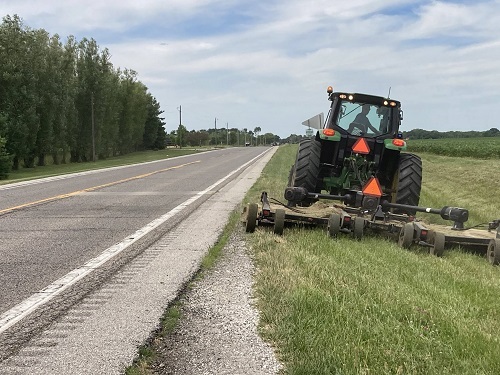The Illinois Department of Transportation recently kicked off its statewide mowing campaign, which will continue until August 15; an effort the agency said plays a key role in its pollinator preservation efforts.
[Above photo by Illinois DOT]
During the summer months, the agency said it conducts two primary types of mowing. The first is safety mowing, which occurs directly adjacent to the road as needed. The second and more involved operation is maintenance mowing, which lasts for approximately six weeks – from around July 1 through August 15.
Meanwhile, maintenance mowing encompasses areas next to culverts, ditches, traffic control devices and other structures, while following the Illinois Monarch Project Mowing Guidelines for Pollinators, protecting as much habitat and nectar resources as possible, Illinois DOT noted.
The agency added that its mowing schedule helps to minimize the impact on the traveling public while encouraging pollinator activity that aids in the reproduction of flowers, fruits, and vegetables that are essential to the state’s ecosystem and economy.
Reducing the amount of land maintained and growing pollinator habitat also protects the endangered rusty patched bumble bee and the monarch butterfly, the latter of which is the official state insect of Illinois, the department pointed out.
“Timely, strategic mowing is an essential part of Illinois DOT’s green efforts,” said Omer Osman, the agency’s secretary, in a statement. He added that, in 2020, IDOT joined in the launch of the Illinois Monarch Action Plan as part of the Illinois Monarch Project, a collaborative effort with local and state partners to help ensure the survival and successful migration of monarchs by increasing and protecting habitat.
Roadway mowing operations can also provide other benefits as well in other areas of the country. For example, the Wyoming Department of Transportation recently noted in a 2023 video that while its mowing operations improves visibility for drivers and removes forage, which helps keeps wildlife away from the roads, it also helps with winter highway maintenance needs as well.
“Most of the reason we mow is to help prevent drifting,” explained Carson Morales, a heavy equipment operator for the agency, in that video. “When the grass is high, it gives the snow more places to catch. The wind keeps piling it in there and we can’t do much with it once it gets stuck there.”

